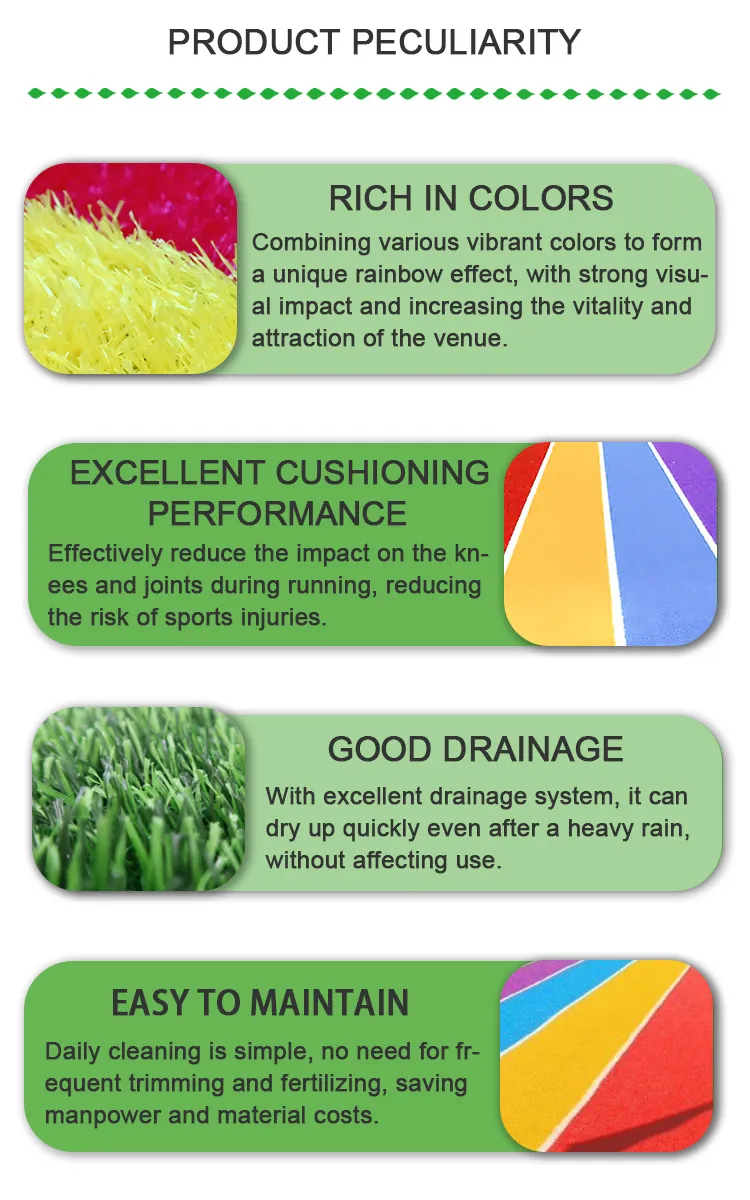
- Afrikaans
- Arabic
- Belarusian
- Bengali
- Czech
- Danish
- Dutch
- English
- Esperanto
- Estonian
- Finnish
- French
- German
- Greek
- Hindi
- Hungarian
- Icelandic
- Indonesian
- irish
- Italian
- Japanese
- kazakh
- Rwandese
- Korean
- Kyrgyz
- Lao
- Latin
- Latvian
- Malay
- Mongolian
- Myanmar
- Norwegian
- Persian
- Polish
- Portuguese
- Romanian
- Russian
- Serbian
- Spanish
- Swedish
- Tagalog
- Tajik
- Thai
- Turkish
- Turkmen
- Ukrainian
- Urdu
- Uighur
- Uzbek
- Vietnamese
artificial turf cricket pitch
Nov . 21, 2024 00:39 Back to list
The Rise of Artificial Turf Cricket Pitches
Cricket, often dubbed as the gentleman's game, has a rich history steeped in tradition. However, in recent years, the evolution of the sport has led to several innovations, one of the most notable being the introduction of artificial turf cricket pitches. This development has transformed the way the game is played, offering numerous advantages over traditional grass surfaces.
Understanding Artificial Turf
Artificial turf, commonly referred to as synthetic grass, is an engineered surface made from synthetic fibers. It is designed to mimic the appearance and feel of natural grass while providing a more durable and consistent playing surface. Over the decades, advancements in technology have led to the creation of high-quality synthetic materials that can withstand the wear and tear of cricket matches, making it an attractive alternative to traditional pitches.
Benefits of Artificial Turf Cricket Pitches
1. Durability and Low Maintenance One of the primary benefits of artificial turf is its durability. Unlike natural grass pitches, which require extensive upkeep—such as mowing, watering, and fertilizing—artificial pitches are designed to endure consistent use with minimal maintenance. This makes them particularly advantageous for clubs and schools that may lack the resources for continuous groundskeeping.
2. Consistency in Playing Conditions The performance of natural grass pitches can be heavily influenced by weather conditions. Factors such as rain, sunlight, and temperature can lead to inconsistent bounce and behavior of the ball. In contrast, artificial turf provides a uniform surface, ensuring that players can rely on consistent playing conditions regardless of external factors. This uniformity is crucial for training and matches, allowing players to focus solely on their game.
3. Weather Resilience Artificial pitches can handle various weather conditions without significant impact on playability. Rain can make natural grass surfaces slippery and difficult to play on, often leading to cancellations or postponements. Synthetic surfaces drain water effectively, allowing for faster recovery after rainfall and increasing the likelihood of matches proceeding as scheduled.
artificial turf cricket pitch

4. Cost-Effectiveness Although the initial installation of artificial turf can be significant, it often proves to be a cost-effective solution in the long run. The reduced need for maintenance, combined with the increased usage opportunities, means that clubs can host more matches and training sessions without the fear of damaging the pitch. This can lead to increased revenue generation through bookings and events.
5. Increased Accessibility Accessibility is another critical aspect of artificial turf pitches. Given their durability and minimal maintenance requirements, these pitches can be used by a wider range of players, including schools and community teams. The availability of quality playing surfaces encourages participation in cricket and promotes grassroots development.
Environmental Considerations
While artificial turf presents several advantages, it is essential to address the environmental concerns associated with its production and disposal. Synthetic materials can have a significant carbon footprint, and the microplastics from wear and tear can also pose risks to local ecosystems. However, the industry is evolving with innovations focusing on sustainability. Some manufacturers are now producing recyclable options and developing technologies to mitigate environmental impacts.
The Future of Cricket
As cricket continues to grow globally, the integration of artificial turf pitches may become even more widespread. The benefits of these surfaces align well with the increasing demand for accessible and high-quality sporting facilities. Moreover, with the rise of formats like T20 and the greater frequency of matches, the ability to maintain consistent playing conditions becomes paramount.
In conclusion, artificial turf cricket pitches represent a modern evolution in the world of cricket. Their durability, low maintenance requirements, and consistent playing conditions make them an attractive choice for clubs, schools, and communities. While it is vital to remain conscious of environmental impacts, the continued advancements in synthetic materials and recycling initiatives promise to make artificial turf a sustainable option for the future of the sport. As cricket moves forward, embracing innovation while respecting tradition will be crucial, and artificial turf pitches are undoubtedly playing a significant role in this journey.
-
The Benefits of Artificial Turf for Indoors
NewsJul.15,2025
-
How Artificial Grass Suppliers Ensure Quality Products
NewsJul.15,2025
-
Artificial Grass and Pets: A Space for Relaxation
NewsJul.08,2025
-
Balcony & Outdoor Decoration with Artificial Grass
NewsJul.08,2025
-
Best Indoor Artificial Grass for Home
NewsJul.07,2025
-
Best Pet Turf for Dogs: Safe & Durable Artificial Grass Options
NewsJul.07,2025
Products categories









